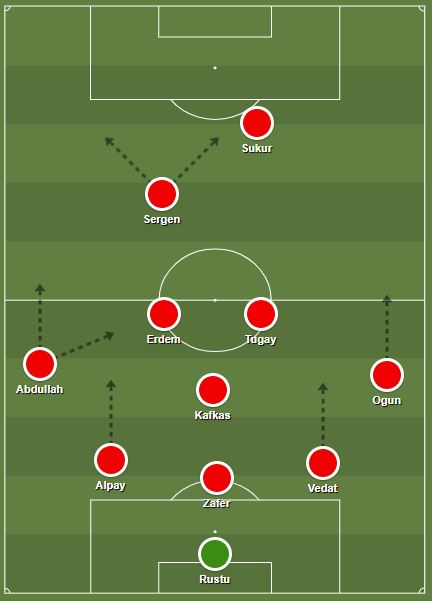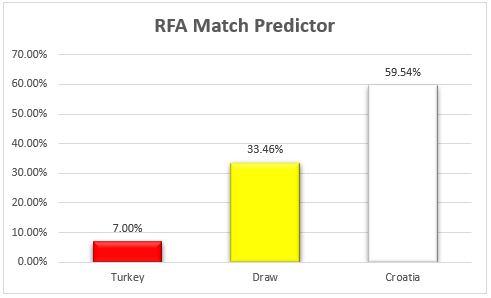Turkey were extremely comfortable on the ball at the back, which gave them the ability to build possession but also play direct accurate passes into the forwards.
Sukur was the lone striker with Sergen playing underneath & between the lines, but could run in behind should a ball be flicked on by Sukur.
Ogun & Abdullah patrolled the flanks offensively & defensively, with both showing a comfort level to dribble inside & combine centrally as well as attack wide & cross into the box.
Erdem, Tugay & Kafkas all very fluid in their movement to combine, pick up the ball & switch the play, forming a solid engine room of Turkey’s attack.
Turkey Starting X1

Croatia operated within a very functional 352 system. They used lots of direct entries into the final third in build up and were very aggressive in moments of transition to get the ball into the strikers.
Boksic & Suker were very much split forwards, rarely linking up centrally, more often they would pull into wide areas and look to cross for each other in a more traditional winger/striker partnership.
Jarni & Stanic provided a lot of support from wide areas, both in attack and defence, but their primary function was to stretch the opposition to allow Croatia’s central midfield three more time and space to operate.
Asanovic and Boban are wonderful footballers, each comfortable on the ball and did their best work when playing penetrative passes into the flanks. Prosinecki played within a free role in the attacking midfield position, using his creativity and movement to pick up play and generate attacks on goal in all phases of the game.
Croatia Attacking Structure

WHAT DO THE NUMBERS TELL US?

Value of Chances
xG Timeline:
While this was a match with low chance creation, it was still a very even contest that was very much in the balance for the opening 65 minutes. After which Croatia were handed several chances that they failed to take, but it began to lift their expected goals value & the late winner proved to be a deserved outcome.
Chance Quality:
Turkey not only failed to create enough chances, given their superior possession, but also the lack of penetration into the box saw them record efforts that extremely low probability of converting into a goal.
Conversely Croatia would create a number of high quality chances, but would fail to capitalize upon a decent amount of them, which is highly surprising given the quality of forwards they have at their disposal.
Type of Chances Created

Turkey’s inability to effectively create chances came down to two contributing factors. First of all they came up against a very dynamic defence & midfield, that many teams at this level would struggle to break down, but they also conspired to their own downfall as they simply couldn’t get enough numbers around or past Sukur as the target striker. While there was lots of nice build up play from Turkey to get into the midfield, quite often an attack would turn over due to poor decision making & a lack of defensive structure to immediately apply counter pressure. As such we saw a 2/2/2 split between their 6 attacks (Regular/Fast Break/Set Pieces), which tells us whatever it was they were trying to create simply didn’t come off consistently/if at all.
Croatia’s main attacking threat throughout the match was via counter attacks, a method they used 3 out of their 8 attacks at goal. Two of these counters would land on target, the most important of which coming in the 85th minute as Vlaovic raced away to score the winning goal. Breaking down their counter attack play further we saw that instead of a vertical attacking game, they preferred to stretch the play & counter through the wings when moving toward goal, a set up that relied heavily on the wing backs energy to get forward and the strikers to split into wide areas and combine on the ball side. Croatia set up 5 of their attacks on goal from crosses, however their lack of quality in front of goal is best evidenced through only 1 of these cross attacks actually landing on target.
Where Chances are Created

The contrast between the teams shot locations is immediately evident, with all 6 of Turkey’s chances coming from outside the box, and 7 of Croatia’s 8 attacks coming from inside the box.
As such Turkey wouldn’t land a single attack on target in the match, something that they will have to rectify for the next match. In a similar vein Croatia will probably feel the same way, with only 3 of their 7 attacks landing on target. Delving deeper again we see that 5 of Croatia’s shots came from the Golden Zone (The center of the 18 yard box), yet only one of these would hit the target.
Who Created Chances
Turkey were starved of anyone who made a genuine statistical impact, so it’s very slender best would be Hakan Sukur with one key pass & one attack.
Croatia had a mix of creative impact during the game, but in terms of overall effectiveness I am going to award it to Goran Vlaovic. Coming on as an early sub in the match he would have two shots on goal, both of which landed on target, and one of which would result in a goal.
Match Predictor
Using our very own Retro Football Analysis Match Simulator, we use the probability rating of each attack to calculate the odds of the matches outcome. Here are the results we got back.

Our verdict:
I think Croatia will be disappointed not to have really put themselves out of sight in this match. Turkey’s 7% chance is actually quite kind given where their attacks came from, which compliments Croatia’s solidity, however they will need to build up some goals if they are to realize their potential at this tournament.


